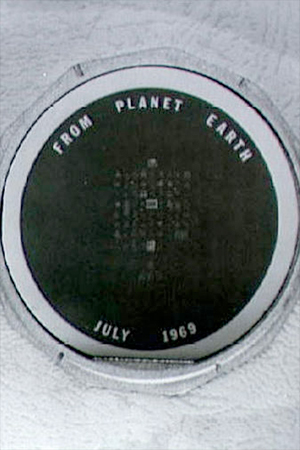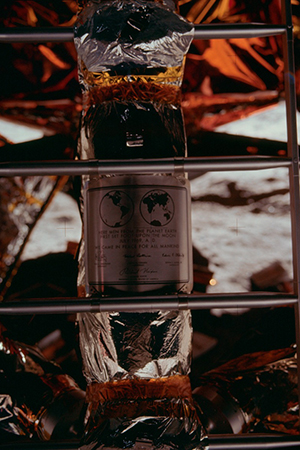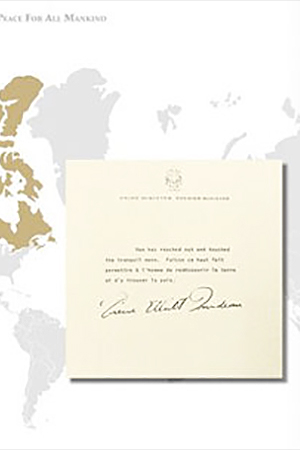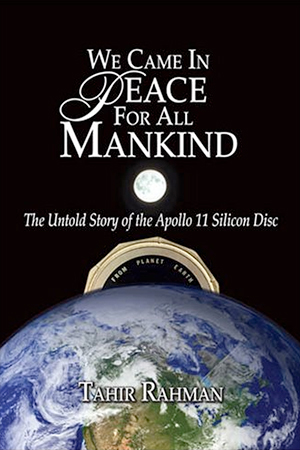November 15, 2007 — Within a few feet of the first boot print made on the moon, under the ladder on which a U.S. flag was stowed and a commemorative plaque is still attached, lies a small white cloth pouch. Inside that bag, next to a couple of embroidered emblems, medals and a gold olive branch, is a small case. Contained within that thin metal sheath is a silicon disc about the size of a half dollar coin. Etched onto that disc, in letters no larger than one-fourth the width of a human hair, are 73 messages.
Such an item, as small as it is, hidden as it was, could be mistaken as insignificant and easily forgotten. And it almost was... twice, as Tahir Rahman, a Kansas-based physician and space history enthusiast reveals in his new book, "We Came in Peace for All Mankind: The Untold Story of the Apollo 11 Silicon Disc."
Rahman, who as a hobby collects Apollo 11 memorabilia, in particular letters and documents signed by astronaut Neil Armstrong, recently came across a duplicate of the disc deposited on the moon and became curious as to its history.
"I thought I knew most aspects of the Apollo 11 mission," Rahman wrote to collectSPACE. "When I acquired a disc for my collection, I quickly discovered that only a sentence or two was mentioned about it in space history books." So, Rahman set about filling in the missing story.
After deciding to plant an American flag on the moon and before the wording was finalized for the plaque declaring that "we came in peace for all mankind," the U.S. State Department authorized NASA to solicit messages of good will from the leaders of the world's nations to be flown and left on the moon.
There were only two minor challenges: NASA didn't know yet how they would archive those messages for flight and as it was June 1969, there was only one month remaining before Apollo 11 would launch for the lunar surface.
"I was amazed at how NASA and the State Department rushed to get these messages before launch," Rahman said. In his book, he describes how 116 countries were contacted but only 73 responded in time. Some, confused by the request, replied asking for more details without realizing that the window for their inclusion was closing fast.
"In view of our total ignorance of this project," began a telegram from the King of Thailand included in "We Came In Peace," "would appreciate any information you can provide concerning NASA's invitation to send message... number of countries responding... methods of recording and method of deposit on the moon."
Regarding the 'methods of recording and deposit,' NASA turned to the Sprague Electric Company of North Adams, Massachusetts, for a solution. No stranger to working for the government — the company had designed a firing capacitor for the Manhattan Project — Sprague was also an established NASA contractor with more than 50,000 components of their manufacture already installed in the Apollo 11 spacecraft.
Still, this contract was unique, requiring a new material, a new invention (Rahman includes the text of the patent in the book's appendix) and a short turnaround of just three weeks. Even after devising the technique to inscribe the microscopic messages on the 1.5 inch, 99%-pure silicon disc and delivering a 'final' version just a week prior to lift off, Sprague was sent scrambling again by NASA to add more nations' notes that were late to arrive.
Nor were these messages simple texts. Some included intricate artwork, such as the Vatican's message by Pope Paul VI. Though not visible to the naked eye, a low-power magnification was all that was needed to reveal the mini masterpieces.
"The first time I looked through a microscope at the disc, I was amazed. There were all these messages in foreign languages in beautiful gold scripts. The message from the Vatican in the center was especially stunning with its gold ornate frame," Rahman described.
On July 11, 1969, just five days before a Saturn V rocket was set to take off with Neil Armstrong, Buzz Aldrin, and Michael Collins, Sprague delivered the second, final disc to NASA. The space agency packaged the round wafer in a metal case resembling a woman's make-up compact to protect it during its journey to the moon. That in turn was placed in a small pouch with other commemorative items, which Aldrin would carry in his spacesuit's sleeve pocket.
On July 20, as Collins orbited the moon, Armstrong and Aldrin landed on its surface. History's first moonwalkers had only two and a half hours to explore the lunar terrain, collect 50 moon rocks and set-up scientific instruments. Their checklists also called for them to take part in a few commemorative activities, including erecting the U.S. flag and reading the inscription from the plaque attached to their lander. Unscheduled events, such as a surprise call from President Nixon compressed their timeline further.
Thus, as Aldrin was climbing up the ladder to reenter their spacecraft for their return home, it was Armstrong who remembered the "package" on Aldrin's arm.
"How about that package out of your sleeve? Get that?" Armstrong called out.
"No," Aldrin replied, "want it now?"
"Guess so," Armstrong said, and with that Aldrin tossed the package — silicon disc tucked inside — down to the moon's surface. Armstrong then nudged it with his foot.
"Okay?" Armstrong asked of its placement.
"Okay," responded Aldrin, which was all the pomp and circumstance the disc would ever receive.
Mission Control also seemed to have forgotten about the disc until the astronauts were safely back inside the lunar lander. Calling up from Houston, astronaut Owen Garriott asked for the moonwalkers to verify that the disc was on the surface "as planned."
"The [transcript] shows that the astronauts almost forgot to leave it on the moon. Buzz Aldrin confirmed that when I interviewed him," observed Rahman. "The mission was designed for safety first, so I can't say more attention should have been paid to it. I am just glad it got there!"
Despite the nonchalant way in which it was treated nearly 40 years ago, Rahman feels that its relevance to today's world has grown, a message he hoped to put forth by his book.
"The Apollo 11 plaque which states 'We Came in Peace for all Mankind' is one of the most important documents in world history — so are those goodwill messages," said Rahman. "The disc is on silicon, which is the basis of our current century, in almost every device we own."
Rahman's "We Came In Peace" reprints each of the 73 goodwill messages, as well as those which were received too late for inclusion on the disc. Each two-page spread includes an English transcription and where available, a scan of the original letter that was used to create the disc images.
"It took them two months to locate the boxes that NASA administrator Thomas Paine had preserved for posterity," Rahman explained of the records he and his researchers found at the Library of Congress.
Formatted as a coffee-table style book, Rahman claims "We Came In Peace" is also unique for its illustrations. "No other book has this many full-page, color Apollo 11 photos," he told collectSPACE, explaining he had the permission of Aldrin and Armstrong for their inclusion.
"We Came In Peace" also documents, though in lesser detail, the stories behind the U.S. flag, lander leg plaque, and the other items that were packed inside the bag with the silicon disc.
Now that its history is in print, at a time when nations are planning to return to the moon, Rahman hopes the silicon disc can be left undisturbed.
"It should stay right there," declares Rahman. "As Buzz Aldrin said to me — it will last on the lunar surface for thousands of years. I hope it does just that — right where he left it."
"We Came In Peace For All Mankind: The Untold Story Of The Apollo 11 Silicon Disc" by Tahir Rahman was set for release today from Leathers Publishing. Priced at $40, the 304-page hardcover book can be ordered, signed by the author, through silicondisc.com or through online booksellers Amazon.com and Barnes & Noble. |
|

The Apollo 11 silicon disc (right) placed near a half-dollar coin to illustrate its relative size. (NASA)

The plaque affixed to Apollo 11's lander leg. It read in part "We Came In Peace For All Mankind". (NASA)

An example of the scanned messages as they are presented in "We Came In Peace For All Mankind". (silicondisc.com)

Cover art for "We Came in Peace for All Mankind: The Untold Story of the Apollo 11 Silicon Disc" by Tahir Rahman. (silicondisc.com) |
